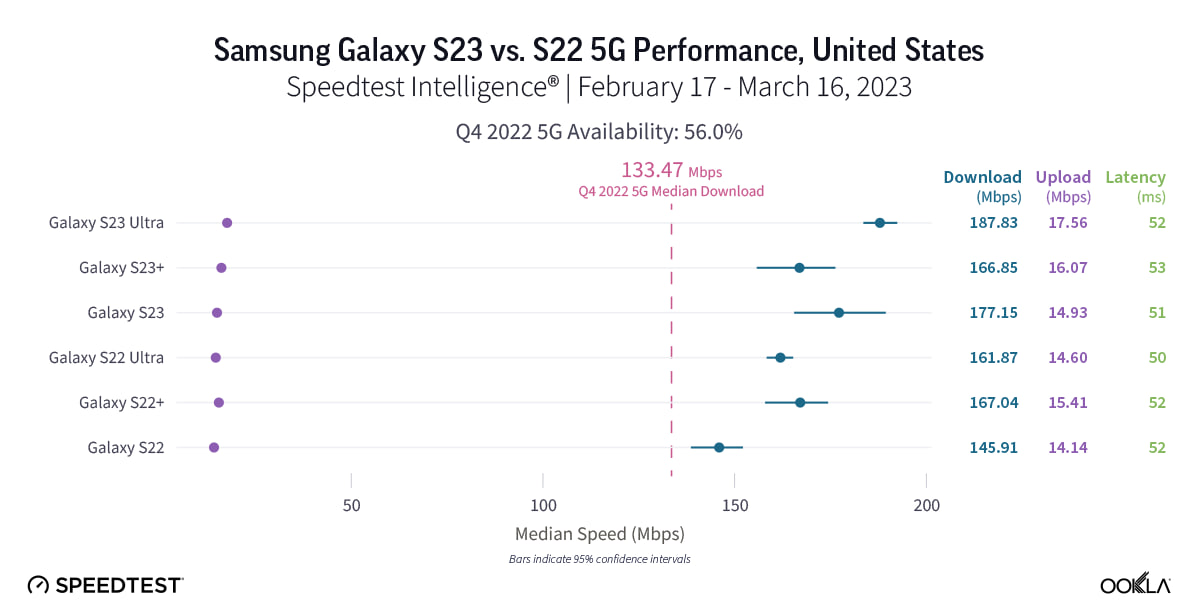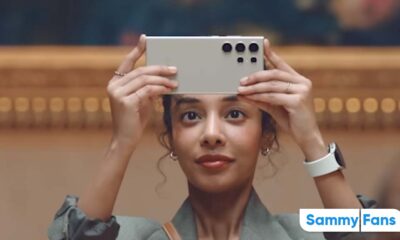News
Samsung Galaxy S23 is a decent upgrade in the US: Ookla 5G Speed Test

Recently, Ookla published its analysis on how the newly launched Samsung Galaxy S23, S23 Plus, and S23 Ultra performed over 5G against the S22 series in the US and other key markets. Speedtest Intelligence data revealed that the Galaxy S23 and S23 Ultra outperformed their predecessors in 5G download speed tests.
Follow our socials → Google News, Telegram, Twitter, Facebook
In the first month after launch, the vanilla and most premium Samsung Galaxy S23 variants swiftly defeated the Galaxy S22 and Galaxy S22 Ultra in the 5G download speed test in the US, reports Ookla. However, the S23+ and S22+ were statistically too close to call.
The vanilla Galaxy S23 smartphone raced ahead of the Galaxy S22 at 177.15 Mbps to 145.91 Mbps, and the Galaxy S23 Ultra was faster than the Galaxy S22 Ultra at 187.83 Mbps to 161.87 Mbps. All of the Galaxy S22 and Galaxy S23 models outperformed the median 5G download speed in the US during the last quarter of 2022.
The S23 Ultra was the only S23 series model to statistically outperform its counterpart for median 5G upload speeds, with an upload speed of 17.56 Mbps to 14.60 Mbps. Looking at median multi-server latency over 5G, the S23 Ultra edged ahead of its S22 Ultra counterpart 50.44 ms to 51.52.

Ookla Recommendation:
U.S. Samsung Galaxy S22 users shouldn’t hesitate to upgrade to the S23 models, especially for the new features and hardware — particularly if you want the S23 Ultra’s 200 MP camera. With 5G networks increasingly getting faster, we suspect the S23 models have yet to see their full potential in the U.S., too.
“If you have 5G and a Samsung Galaxy S22 in the United States, don’t hesitate to upgrade to an S23 model,” said Ookla.
S23 Series Vs S22 Series: Key Upgrades
Samsung Galaxy S23 series is equipped with Qualcomm’s Snapdragon 8 Gen 2 for Galaxy processor, while the Galaxy S22 series uses Snapdragon 8 Gen 1 in the US. The latest flagships use a Snapdragon X70 modem, while the last year’s lineup has a Snapdragon X65 modem.
S23 Vs S22
- The S23 has a bigger battery capacity at 3,900 mAh over the S22’s 3,700 mAh
- The S23 has slightly better ultra-wide and front cameras and video recording capabilities
S23 Plus Vs S22 Plus
- The S23+ has expanded storage capacity at a base level of 256 GB (which can be upgraded to 512 GB) over the S22+’s base of 128 GB
- The S23+ has a bigger battery capacity at 4,700 mAh over the S22+’s 4,500 mAh
- The S23+ has slightly better ultra-wide and front cameras and video recording capabilities
S23 Ultra Vs S22 Ultra
- The S23 Ultra has expanded storage capacity at a base level of 256 GB (which can be upgraded to 512 GB) over the S22 Ultra’s base of 128 GB
- The S23 Ultra has much better main camera, with up to 200 MP vs. the S22 Ultra’s maximum of 108 MP
News
Here’s why Google Messages replaced Samsung Messages on Galaxy devices

Samsung’s latest foldable phones come with Google Messages by default. The company has now revealed the reason behind this move on Galaxy devices. Samsung says Google Messages replaced Messages to foster RCS adoption.
According to AndroidAuthority, a source explained Samsung’s decision to switch to Google Messages as the default messaging app. The recently released Galaxy Z Flip 6 and Z Fold 6 come with Google Messages with RCS enabled by default.
Looks like promoting Google Messages on Galaxy devices will boost RCS adoption. Samsung Messages isn’t already installed on newer phones. However, one’s stopping you from getting it on your Galaxy from the Galaxy Store.
While many apps support the RCS feature, Google Messages offer the best user experience. Making it a default messaging app is an effort to boost the adoption of RCS tech. Apple is also preparing to bring RCS chat functionality to iMessage for iPhones.
What Samsung source said:
- Even if messaging apps follow the RCS standard, the availability may be limited depending on which app the other party uses. That’s why we decided to make Google Messages the common messaging platform, allowing Galaxy users to communicate more freely. This also enables a messaging app to respond to changes of the RCS standard more quickly and efficiently.
Previously, Samsung devices launched in the US came with two messaging apps. This time, the company has removed the Samsung Messages. During the first setup, users are notified that Google Messages is the default messaging application.
News
Samsung SmartThings gets ISO 27001 certified

Samsung SmartThings gained the international standard ISO/IEC 27001:2022 certification. The company has officially announced this major development in its global connected living platform.
SmartThings received ISO/IEC 27001:2022 certification for information security management systems. Certification reiterates that the SmartThings Cloud operates per international standards.
To be certified, a company has to meet the standard across a total of 123 detailed items, including policies for information security, access control for information assets, and incident response.
SmartThings receiving the ISO 27001 certification is the result of our sustained focus on the protection of information in a hyper-connected world with exponentially increasing intelligence.
Seungbum Choi, Executive Vice President and Head of Device Platform Center at Samsung Electronics said “this is just another step in our drive to fortify the platform’s security. We will continue to find new ways to ensure that SmartThings’ personalized services are provided even more safely.”

BSI Prez says that they have recognized that the operation capability and security level of Samsung SmartThings is excellent. It will further boost trust in the SmartThings platform and strengthen business competitiveness.
ISO 27001 is the leading global standard for ISMSs and was established by the International Organization for Standardization. It provides companies with guidance to manage the risks to information assets systematically and achieve information protection goals.
News
Dr.diary fuels Samsung Health with glycated hemoglobin algorithm
Samsung Health app integrated the Dr.diary (Doctor Diary) glycated hemoglobin feature. The blood sugar management platform announced the launch of its glycated hemoglobin estimation functionality on Samsung’s Health application.
According to ETNews, Dr.diary announced the integration of a glycated hemoglobin level feature in Samsung Health. Galaxy users will now be able to check the estimated glycated hemoglobin level provided by Doctor Diary.
To activate the feature, Health app users will have to permit certain conditions of data in the Blood Sugar service. It is worth noting that glycated hemoglobin is a key figure for diabetes diagnosis, which users will find worth using in the Health app.
Established in 2017, Dr.diary is a blood sugar management platform. It analyzes and predicts the changes in glycated hemoglobin using its own algorithm. Earlier this year, the firm secured a patent for “glycated hemoglobin estimation based on blood sugar data table.”
Song Je-yoon, CEO of Doctor Diary, said, “With our predicted glycated hemoglobin level prediction algorithm being installed in Samsung Health, more people will be able to recognize their glycated hemoglobin level and manage their health more efficiently.”

Glycated hemoglobin (HbA1c) is a standardized numerical value of the percentage of hemoglobin, such as hemoglobin, which has been glycated by glucose. Glycated hemoglobin reflects the average blood sugar level over the past 2-3 months.
Samsung Health (with Wear OS Galaxy Watch) users can conveniently check their estimated glycated hemoglobin level within the app and use this information to manage their blood sugar levels through diet and exercise.












